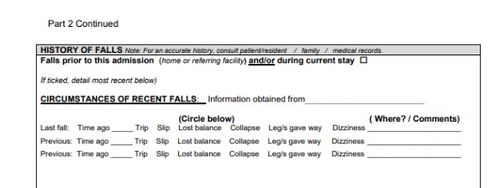The Definitive Guide to Dementia Fall Risk
Table of ContentsGetting My Dementia Fall Risk To WorkSee This Report about Dementia Fall RiskThe Single Strategy To Use For Dementia Fall RiskThe Main Principles Of Dementia Fall Risk
A fall risk evaluation checks to see just how likely it is that you will certainly drop. It is mostly provided for older grownups. The analysis usually consists of: This includes a series of inquiries about your general wellness and if you have actually had previous drops or problems with balance, standing, and/or walking. These devices test your stamina, balance, and gait (the method you stroll).Treatments are suggestions that may reduce your risk of dropping. STEADI includes three actions: you for your danger of falling for your risk factors that can be enhanced to attempt to protect against drops (for example, balance problems, damaged vision) to minimize your threat of dropping by utilizing effective approaches (for instance, supplying education and sources), you may be asked several inquiries consisting of: Have you fallen in the previous year? Are you worried concerning falling?
If it takes you 12 secs or more, it might imply you are at greater risk for a fall. This examination checks strength and balance.
The positions will obtain tougher as you go. Stand with your feet side-by-side. Move one foot midway onward, so the instep is touching the huge toe of your various other foot. Move one foot completely in front of the various other, so the toes are touching the heel of your other foot.
4 Simple Techniques For Dementia Fall Risk
Most falls occur as an outcome of numerous adding aspects; as a result, taking care of the threat of falling starts with determining the variables that add to drop risk - Dementia Fall Risk. Several of one of the most pertinent danger variables include: History of previous fallsChronic clinical conditionsAcute illnessImpaired gait and equilibrium, lower extremity weaknessCognitive impairmentChanges in visionCertain risky medicines and polypharmacyEnvironmental aspects can also increase the risk for drops, consisting of: Inadequate lightingUneven or damaged flooringWet or unsafe floorsMissing or damaged handrails and get barsDamaged or improperly equipped devices, such as beds, mobility devices, or walkersImproper use assistive devicesInadequate guidance of the individuals living in the NF, consisting of those who exhibit aggressive behaviorsA effective fall threat monitoring program needs a complete medical analysis, with input from all members of the interdisciplinary team

The treatment plan should additionally consist of interventions that are system-based, such as those that advertise a risk-free setting (suitable lights, hand rails, get bars, and so on). The effectiveness of the treatments ought to be reviewed occasionally, and the care strategy revised as essential to show changes in the autumn risk evaluation. Implementing an autumn risk monitoring system using evidence-based finest technique can minimize the frequency of drops in the NF, while restricting the capacity for fall-related injuries.
Getting My Dementia Fall Risk To Work
The AGS/BGS standard advises screening all grownups matured 65 years and older for autumn risk yearly. This testing contains asking patients whether they have actually dropped 2 or even more times in the past year or sought medical interest for an autumn, or, if they have not fallen, whether they feel unsteady when walking.
People who have actually dropped as soon as without injury should have their balance and gait assessed; those with gait or balance irregularities must get additional evaluation. A history of 1 fall without injury and without stride or equilibrium troubles does not require further assessment past ongoing annual fall threat testing. Dementia Fall Risk. A loss threat analysis is needed as part of the Welcome to Medicare evaluation

Top Guidelines Of Dementia Fall Risk
Recording a falls history is just one of the quality signs for fall prevention and management. A critical component of risk evaluation is a medicine testimonial. A number of courses of medications boost fall threat (Table 2). Psychoactive drugs in specific are independent forecasters of drops. These medications tend to be sedating, modify the sensorium, and harm balance and gait.
Postural hypotension can frequently be eased Read More Here by reducing the dosage of blood pressurelowering medications and/or quiting medications that have orthostatic hypotension as a side result. Use above-the-knee support tube and sleeping with the head of the bed elevated may also reduce postural reductions in blood pressure. The advisable components of a fall-focused physical exam are received Box 1.

A yank time better than browse around these guys or equivalent to 12 secs suggests high loss threat. The 30-Second Chair Stand examination evaluates lower extremity toughness and equilibrium. Being not able to stand up from a chair of knee height without using one's arms shows boosted autumn danger. The 4-Stage Balance examination examines static equilibrium by having the individual stand in 4 settings, each considerably more challenging.